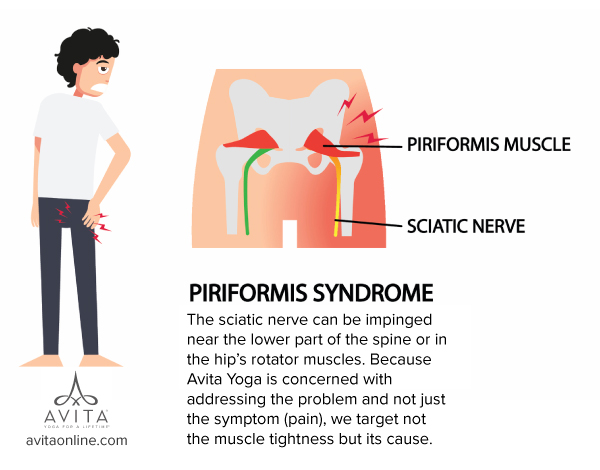Sciatic pain can disrupt daily life, making even simple tasks feel overwhelming. However, relief may be closer than you think with yoga for sciatica.
Avita Yoga provides a gentle, restorative approach that addresses the root causes of sciatic discomfort rather than just the symptoms. By focusing on mindful movements and tailored shapes, this method helps alleviate tension in the lower back and hips, improving flexibility and encouraging long-term healing. With its emphasis on ease and accessibility, Avita Yoga is suitable for anyone seeking a natural, sustainable solution to sciatic pain.
Almost everyone experiences some degree of sciatic pain during their lifetime. While anyone can develop sciatic pain, it occurs more frequently in individuals who spend long hours sitting, such as drivers and desk workers. The sciatic nerve exits the spinal cord at the lower part of the spine, near the sacrum, and travels through the hip’s “deep six” rotator muscles. One of these external hip rotators, the Piriformis muscle, often pinches the sciatic nerve, leading to Piriformis Syndrome.

Resolving Sciatic Pain
The sciatic nerve can be impinged near the lower part of the spine or in the hip’s rotator muscles. Because Avita Yoga is concerned with addressing the problem and not just the symptom (pain), we target not the muscle tightness but its cause. Many things can cause a muscle to spasm and tighten and, in this case, cause pain or tingling down the leg via the sciatic nerve. Chief among them is hip impingement at the level of the bone or the surrounding connective tissue. Sometimes there is an arthritic or degenerative quality in the hip that can, in turn, cause adjacent muscles to cramp or tighten.
How Avita Yoga for Sciatica Relieves Muscle Tension
Stretching the muscle may help resolve pain in the short term but not in the long term, and certainly won’t address the deeper cause. Stretching muscles alone also come with risk, but that’s another story.
Avita Yoga and the specific shapes chosen in the miniseries will also target the problem if the origin of it is closer to the spine and sacrum. The same degenerative issues at the spine, combined with lack of movement in this part of the body, can lead to nerve impingement and radiating pain. Avita Yoga helps you regain all of your body’s motions from tip to tail, and where there is movement, there is health.
A Little Prevention Can Go a Long Way
When it comes to managing and avoiding sciatic pain, a proactive approach can make all the difference. Incorporating yoga for sciatica into your daily routine is an excellent way to prevent discomfort and maintain spinal health. Gentle stretches and targeted poses can release tension, improve flexibility, and strengthen supporting muscles, reducing the likelihood of flare-ups.
Avita Yoga offers simple yet effective techniques that not only ease existing pain but also promote long-term well-being. Remember, taking small preventive steps today can lead to a healthier, pain-free tomorrow.
Enjoy this SCIATIC MINISERIES and if you find it helpful, consider taking care of the rest of your body in the same manner.
Namaste, Jeff

